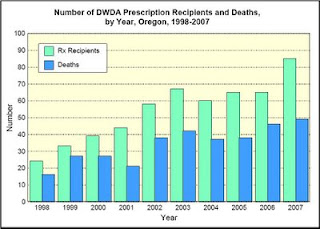Summary of Oregon’s Death with Dignity Act - 2007
Death with Dignity is the title of the state of Oregon's law which allows physician assisted suicide for its residents under strict rules. Each year, the Oregon Department of Human Services provides data regarding the utilization of that law. The following is the document that was made public for the 2007 experience. The figure below is the number of Death with Dignity Act prescription recipients and deaths by year in Orgeon 1998-2007. As you can see from the data,the Death with Dignity Act, while giving all terminally ill Oregon citizens an opportunity to make their own decisions about their deaths, the numbers of cases involved and the resultant numbers of deaths experienced from the presence of this law over the past 10 years has been trivial compared to numbers which had been predicted by some. ..Maurice.

Oregon’s Death with Dignity Act (DWDA) allows terminally ill adult residents to obtain and use prescriptions from their physicians for self-administered, lethal doses of medications. The Oregon Department of Human Services is required by the Act to collect information on compliance and to issue an annual report. The key findings from 2007 are listed below. Formore detail, please view the tables on our web site: http://oregon.gov/DHS/ph/pas/index.shtml.
•During 2007,85 prescriptions for lethal medications were written under the provisionsof the DWDA compared to 65 during 2006 (Figure). Of these, 46 patients took themedications, 26 died of their underlying disease, and 13 were alive at the end of 2007. In addition, three patients with earlier prescriptions died from taking the medications, resulting in a total of 49 DWDA deaths during 2007. This corresponds toan estimated 15.6 DWDA deaths per 10,000 total deaths.
•Forty-five physicians wrote the 85 prescriptions (range 1-10).
•Since the DWDA was passed in 1997, 341 patients have died under the terms of thelaw.
•As in prior years, most participants were between 55 and 84 years of age (80%)white (98%), well educated (69% had some college), and had terminal cancer (86%).Patients who died in 2007 were younger (median age 65 years) than in previousyears (median age 70 years).
•During 2007, more patients resided in the Portland Metropolitan area (Clackamas,Multnomah, and Washington counties) (55%) compared to prior years (39%).
•All patients had some form of health insurance: 65% had private insurance, and 35%had Medicare or Medicaid.
•As in previous years, the most frequently mentioned end-of-life concerns were: loss of autonomy (100%), decreasing ability to participate in activities that made life enjoyable (86%), and loss of dignity (86%). During 2007, more participants were concerned about inadequate pain control (33%) than in previous years (26%).
•Most patients died at home (90%) and were enrolled in hospice care (88%).
•Complications were reported in three patients during 2007; they all regurgitated someof the medication. One person lived 3½ days.
•During 2007, no physician referrals were made to the Oregon Medical Board

2 Comments:
Very interesting to see these statistics. I've noticed that we are great at asking for patient participation and autonomy in decisions about care unless they would like to decrease or eliminate efforts to keep them alive; at that point, we often balk as a profession at extending people the right to control their own fate.
I've blogged about the preservation of dignity despite maximal, and probably futile, intervention, but it does seem to me that current decisions are more driven by liability than dignity.
Nice post..I've noticed that we are great at asking for patient participation and autonomy in decisions about care unless they would like to decrease or eliminate efforts to keep them alive
---------------------------------
williams
Oregon Alcohol Addiction Treatment
Post a Comment
<< Home